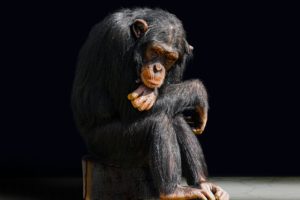 Many of our gestures and emotions are universal across cultures, but is this limited to just our species?
Many of our gestures and emotions are universal across cultures, but is this limited to just our species?
In an exciting new study by Dr. Kirsty Graham of the University of York, researchers found surprising patterns among gestures utilized by bonobos and chimpanzees in the Democratic Republic of the Congo. Not only did they find similarities between these closely related species, but they also noticed amazing parallels with another closely related species: humans.
After watching videos of wild apes, Dr. Graham’s team noticed an amazing 90 percent overlap between the gestures of bonobos and chimpanzees. For this study, gestures were defined as clear nonverbal activities that engendered apparently successful communication between two individuals.
One gesture featured an ape scratching their own shoulder as a request to be groomed, and another saw apes stroking each other’s mouths to ask for food. Some common gestures were similar but had different meanings, just like among humans. For example, a raised arm may request on object move for chimpanzees, whereas bonobos use this gesture to initiate grooming or mating. This could certainly be an egregious miscommunication!
These gestures seem alien, but others are very close to home. If a bonobo looks at you and flaps its hand towards you, chimpanzees, bonobos, and humans alike will all know that this means “move away”!
While some gestures were clearly learned, others were just as clearly evolved and ingrained at the biological level. Given that all three of our species evolved from a common ancestor, a possible link seems almost intuitive.
Perhaps none of this is surprising. In a past blog, we tracked the development of universal emotions based on evolutionary grounds. This built on research that tied emotional expressions to outside stimuli. This included narrowed eyes for disgust, as though we are trying to reduce the amount of disgusting imagery we have to see.
Darwin himself theorized that universal emotions would emerge from evolutionary processes. Thus, the universal nature of human gestures fits into this schema as well. As we discussed in a past blog, Humintell’s Dr. David Matsumoto has found that athletes from around the world celebrate the Olympics in similar fashions, displaying a posture of triumph with arms thrown into the air.
Dr. Matsumoto has even pointed out that this triumphant behavior is similar in primates.
Still, the groundbreaking nature of Dr. Graham’s research does not answer all of our questions. Dr. Richard Moore, a cognitive psychologist from Humboldt University in Berlin, points out that this research only shows the potential of apes to mutually understand each other’s gestures. Moreover, it doesn’t address subtle but possibly important variations in gestures that may complicate the picture.
When we are trying to read other people, we may be tempted to just focus on their eyes or their face, but this sort of research shows how crucial reading the whole body is to gain insights. Moreover, while cultural differences complicate the situation, focusing on universal signals, be they emotions or gestures, can help you read just about anybody, including chimpanzees!